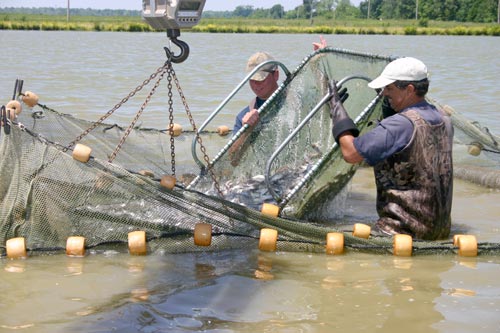March 28, 2011

Increases in feed and fuel prices and the influx of imported fish from Asia are causing a steep reduction in American and Louisiana catfish production. According to USDA figures, catfish processing is down 32 percent from last year nationwide.
Catfish-producing states like Louisiana, Mississippi, Arkansas and Alabama have all reduced the number of acres they have in production, said Dennis Burns, LSU AgCenter county agent in Tensas Parish.“The Louisiana catfish industry is pretty much going out of business. Cheaper imports along with higher fuel and feed prices are squeezing the profit margin out of the business.”
During the heyday of catfish production in the 1980s, Franklin, Catahoula and Concordia parishes were deep into the business. Now, however, catfish farming is almost a thing of the past there, Burns said.
“Louisiana producers were always at a slight disadvantage compared with the producers in Mississippi, Arkansas and Alabama,” said Greg Lutz, LSU AgCenter aquaculture specialist. “Our producers are smaller and there are some infrastructure challenges.
Getting feed at a price that was bearable has been a factor that Louisiana growers have wrestled with for a number of years.
The main problem is that the distance feed has to be shipped to Louisiana producers make it difficult to make a profit, Lutz said. And even with two catfish processing plants in the delta area of the state, the low number of producers forced the facilities to struggle to operate efficiently.
“The plant in Henderson, in the southern part of the state, has survived by bringing in product from out of state and taking advantage of specialized markets,” Lutz said.
In Louisiana, total acreage for catfish production has dropped from 12,100 in 2002 to just under 2,000 acres in 2010.
“Starting around 2000, it became hard for our growers to get financing, even though they were some of the best producers in the industry,” Lutz said.
By 2005, when interest in ethanol increased, the price of feed went from $220 per ton to $450 per ton, which hurt the remaining Louisiana producers.
“Alabama is trying to hang on, but growers in these other states are draining ponds and putting the land either into the Conservation Reserve Program or putting it back into row crop production or pasture,” Burns said.
Because of price pressure caused by imported catfish, the Catfish Farmers of America (CFA) has begun an effort to get legislation to require country of origin labeling on restaurant menus, according to Joey Lowery, chairman of the CFA board.“We feel if people are given the choice and are correctly informed, they will prefer and demand U.S. farm-raised catfish.”
Despite continuing declines in acreage, Louisiana still ranks fourth among catfish-producing states, according to the LSU AgCenter 2010 Louisiana Summary of Agriculture and Natural Resources.
Declines in catfish production continued and even accelerated in 2010, but Louisiana was not the only state with declining numbers. Louisiana catfish acreage decreased by 49 percent from 2009 to 1,334 acres of ponds, but producers still sold nearly 5 million pounds of catfish valued at $3.9 million.
Downward pressure on prices, combined with significantly increasing costs for feed and fuel caused even more significant declines in 2010 catfish acreage in neighboring states: 13 percent in Mississippi and 31 percent in Arkansas.
You May Also Like




